The Glass Gem Corn is winding down and I will have a couple more ears to harvest over the next few weeks but today was really the big finale with 4 ears harvested and two that were almost* entirely in the blue spectrum.I plan to make some popcorn from this year's harvest, but also plan to double my planting for year's crop from saved seed. This is a exponential goal/reward because for every one corn plant I plant two black eyed pea plants to nourish the corn and climb the stalk for support and I am enjoying the still growing store of homegrown black eyed peas to cook up for good luck on New Year Day and would like to have even more for New Years 2018.*the bottom right cob has a single green kernel that only makes the rest of the cob look all the more blue.
Read MoreFirst Glass Gem Corn Harvest
I harvested my first ear of Glass Gem Corn yesterday and it is beautiful!
Read MoreJuly Garden Update
Under the best of circumstances July is an awkward time for the garden.Spring greens (spinach, lettuce, cilantro) still in the garden have bolted or browned, strawberries have stopped producing anything but dozens of straggly runners and asparagus has transmogrified into its less known, fuzzy small tree form. Between these only-a-mother-could-love-them beauties are the bare spaces where sugar and snow peas and pak choy have been removed but it is still too early to sow fall plants, July may be the worst time to have a garden guest.I have a garden guest coming next week.The wonderful REALTOR that patiently waited and watched while I stood in potential back yards mentally calculating full sun hours and painstakingly measuring for raised beds that were at the time, stored in a rented garage, is coming to see what I "have done with the place" and late July is the date we picked for dinner and a garden tour.This post is half garden update, half convincing myself that there are still beautiful things to be seen even in this straggly season. Here goes:The blackberries are huge and I should still have a good mix of ripe and unripe next week.I always overseed plants like basil so I can use the thinnings on meals while letting the main plants mature.There is only one butternut squash on the vine so far, but many blooms.I picked my first round of Envy edamame with only a handful left in the garden, but I had left the wonderful nitrogen fixing plants in the garden as companion plantings to everyone else.And the rest of this story is tomatoes, the beauties of summer. These are some of the Blue Cream Berries cherry tomatoes before they ripen and take on that creamy yellow color.The roma tomatoes are thick on the vine and ripening at a steady rate.A pretty average harvest day with a double handful of roma tomatoes, a couple of Mortgage Lifters, a bowlful of Hartman's Yellow Gooseberry cherry tomatoes (the most prolific and tallest of my cherry tomato plants this year) and my first Black Beauty zucchini of the year.Here's hoping she really likes tomatoes ;)
Read MoreOne Boy, Three Sisters
Me: Let me snap a picture before you plant the rest of the seeds.9yo: Sure, but let me grab the dibber first!I served in an advisory capacity last weekend as my 9 year old planted Glass Gem and Strawberry Popcorn, two beautiful heirloom varieties of flint corn he chose for his own garden crop this year. I chose California Blackeye Peas and a gift of Italian squash seeds called Zucchino Tondo Chiaro Di Nizza to be planted with the corn over the coming weeks to create our own Three Sisters planting with our crops growing together, supporting and benefiting each other.As we worked we talked about proper spacing (math), germination (biology), the magic of life held in each one of the seeds in his hand (reverence), and of the future harvest (patience).There is more growing in my garden than just food, I am growing a person.
Read MoreGrowing Sustainability - Part 1
 I have three 24 x 36 cork boards in my home office, devoted to helping me organize my garden. They are filled with seasonal planting guides for Zone 7, my own garden plans for seasonal and succession plantings, companion planting charts and the listings of vegetables by family that make sense of them.Interspersed between these work-a-day printouts are some of my favorite images of the WWI National War Garden Commission (1910-1920) and WWII Victory Garden (1930-1950) posters. I have long been a fan of these nostalgic images for what they represented at the time and what they represent to me* today.The images, although quaint and nostalgic now, when they were produced were part of a bold initiative that is difficult to imagine ever repeating itself in the light of 21st century politics. The world leaders at that time asked of their people to be a little more self-sufficient for a while, to do a little more for themselves and consume less, not for any immediate personal benefit for those making the sacrifices of growing and preserving their own food, but for "the greater good". They also represent a generally accepted, society endorsed back to the land movement long before the Foxfire books of the 1970s solidified in the public mind that unless you are a farmer by trade, growing a significant portion of your own food is a hallmark of an alternative lifestyle.With the War Gardens of WWI and later the Victory Gardens of WWII, ordinary households economized during rationing. They grew, ate, canned and preserved some of their own produce to nourish their families and to help the war efforts by using less of the nation's production and transportation resources so those resources would be available elsewhere.It was a time of lofty and aspirational ideals and pulling together for a purpose larger than ourselves. Some of the growing ideas and solutions promulgated during that period, particularly of WWII were a mix of good and pretty bad, but the overall concept was a good one - a decentralized food system, self-sufficient citizens and a government system that supported the bootstraps mentality that has become a hallmark of those generations.
I have three 24 x 36 cork boards in my home office, devoted to helping me organize my garden. They are filled with seasonal planting guides for Zone 7, my own garden plans for seasonal and succession plantings, companion planting charts and the listings of vegetables by family that make sense of them.Interspersed between these work-a-day printouts are some of my favorite images of the WWI National War Garden Commission (1910-1920) and WWII Victory Garden (1930-1950) posters. I have long been a fan of these nostalgic images for what they represented at the time and what they represent to me* today.The images, although quaint and nostalgic now, when they were produced were part of a bold initiative that is difficult to imagine ever repeating itself in the light of 21st century politics. The world leaders at that time asked of their people to be a little more self-sufficient for a while, to do a little more for themselves and consume less, not for any immediate personal benefit for those making the sacrifices of growing and preserving their own food, but for "the greater good". They also represent a generally accepted, society endorsed back to the land movement long before the Foxfire books of the 1970s solidified in the public mind that unless you are a farmer by trade, growing a significant portion of your own food is a hallmark of an alternative lifestyle.With the War Gardens of WWI and later the Victory Gardens of WWII, ordinary households economized during rationing. They grew, ate, canned and preserved some of their own produce to nourish their families and to help the war efforts by using less of the nation's production and transportation resources so those resources would be available elsewhere.It was a time of lofty and aspirational ideals and pulling together for a purpose larger than ourselves. Some of the growing ideas and solutions promulgated during that period, particularly of WWII were a mix of good and pretty bad, but the overall concept was a good one - a decentralized food system, self-sufficient citizens and a government system that supported the bootstraps mentality that has become a hallmark of those generations.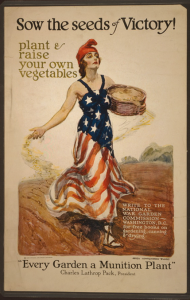 *Results may vary
*Results may vary
Inadvertent Homage
...to Scarborough Fair on my deck.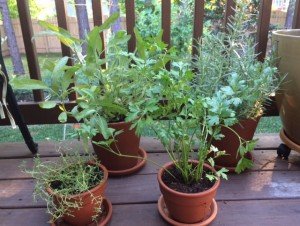 Companion planting 1670 style! Here is the Simon and Garfunkel version if you need to get the song unstuck from your head.
Companion planting 1670 style! Here is the Simon and Garfunkel version if you need to get the song unstuck from your head.
A Collaborative Dance
I think of my garden as a collaborative dance with nature and I am always looking for ways to be a better dance partner.My garden is exactly one square foot smaller than the maximum allowed in the HOA rules so I was loathe to use valuable garden space for non-edible plants. Instead I decided to make flower beds around the pines and larger sweet gumballs that occupy the back 1/3 of my yard.When selecting what flowers to grow, I tried to stick with varieties that are native to this area to be low maintenance, have something blooming from spring through fall and hopefully be just like mom's cooking to the wild pollinators.Lucky for me this includes Lily of the Valley and Balsam (below, pink) with Canterbury Bells and Candytuft (below, purple) being naturalized.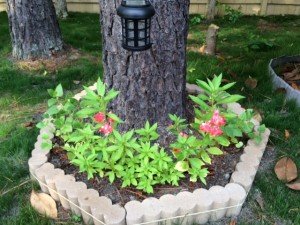
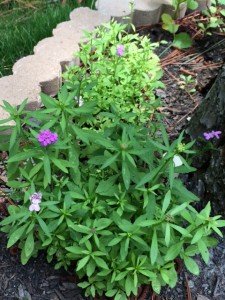 Despite not being native, I couldn't resist Mother of Pearl Poppys (below) and Four O' Clock Sweets.
Despite not being native, I couldn't resist Mother of Pearl Poppys (below) and Four O' Clock Sweets. 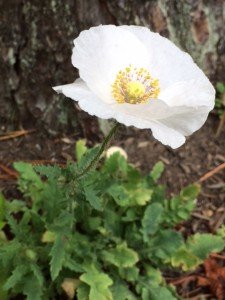 And in spring a colleague gifted me with some pink Calla Lily bulbs.
And in spring a colleague gifted me with some pink Calla Lily bulbs.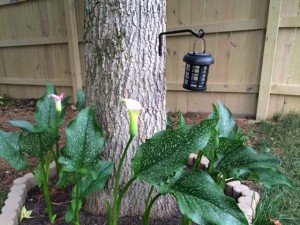 I also have a Malope mix, 3 varieties of sunflowers, Blue Zebra Primrose and Zenias growing.I am trying to encourage nature by giving it what it needs, then mostly staying out of the way while it grows delicious food.
I also have a Malope mix, 3 varieties of sunflowers, Blue Zebra Primrose and Zenias growing.I am trying to encourage nature by giving it what it needs, then mostly staying out of the way while it grows delicious food.
Good Companions, Bad Companions
"It is better to travel alone than with a bad companion"~ African ProverbGardening can be as simple or as complex as we chose to make it and the results will echo our intentions. An inclination to grow a few things will result in exactly that, a few things coming up. A desire to grow food will involve a bit more planning, time and effort to consider which items to grow and how best to grow them. A serious intention to grow as much food as possible within the space available on a continual basis will require careful planning, including crop rotations (which I discussed in a previous post), companion planting considerations (which I will discuss here) and strategic succession plantings to create a rolling harvest.Plants are a bit like dinner guests, there are some that seated side by side will find great pleasure in the symbiotic company and will make new friends while others that if placed in close proximity will antagonize each other. This is mostly related to nutrient and root/leaf space needs of different plant families but can also due to how some plants interact with their proximity (ex: alliums exude a chemical that inhibits the growth in legumes).You don't have to hit the botany books to steer clear of the antagonistic relationships or deduce which plants would make good companions - there are plenty of companion planting charts available online ranging from the very simple to the very complex. A little planning will increase your plants happiness and your harvest. Or you could just wing it ;)



